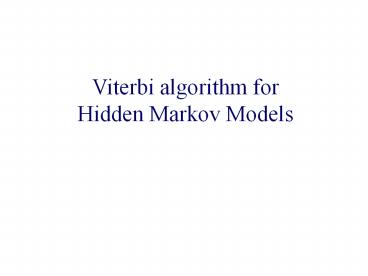Viterbi algorithm for Hidden Markov Models - PowerPoint PPT Presentation
Title:
Viterbi algorithm for Hidden Markov Models
Description:
Discrete Markov chain on state space augmented by ... For each time moment, the process generates state-dependent ... VX = ln(vX) cX, VY = ln(vY) cY ... – PowerPoint PPT presentation
Number of Views:111
Avg rating:3.0/5.0
Title: Viterbi algorithm for Hidden Markov Models
1
Viterbi algorithm forHidden Markov Models
2
Hidden Markov Models
- Discrete Markov chain on state space augmented by
states B and E, with transition probability
matrix a (aij). - State at time i, denoted ?i, i 0, , L1, ?0
B, ?L1 E. States are not observable. - For each time moment, the process generates
state-dependent observable emissions xi, i 0,
, L. Probability of emission is denoted e?(x).
3
(No Transcript)
4
CpG-island example
5
(No Transcript)
6
(No Transcript)
7
Basic questions for HMMs
- Find the most likely path of states, given
observations. - Find the most likely state at a given time
moment, given observations. To accomplish this,
it is necessary to find the distribution of
states at a given time moment, given
observations. - Recurrent algorithm to answer these questions is
dynamic programming (Viterbis version)
8
(No Transcript)
9
(No Transcript)
10
(No Transcript)
11
(No Transcript)
12
(No Transcript)
13
(No Transcript)
14
(No Transcript)
15
(No Transcript)
16
(No Transcript)
17
(No Transcript)
18
(No Transcript)
19
(No Transcript)
20
(No Transcript)
21
(No Transcript)
22
(No Transcript)
23
(No Transcript)
24
(No Transcript)
25
(No Transcript)
26
(No Transcript)
27
(No Transcript)
28
(No Transcript)
29
(No Transcript)
30
HMM for paired alignments
- Internal states, M
- Emissions, M, X, Y, indistinguishable
- In a way, inversion of the real-life situation
True alignment produces sequences X and Y.
31
Viterbi algorithm yields the following recursions
32
Version of the algorithm for VM ln(vM)cM, VX
ln(vX)cX, VY ln(vY)cY
33
Indistinguishable from the Needleman and Wunsch
algorithm































